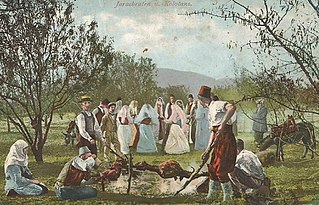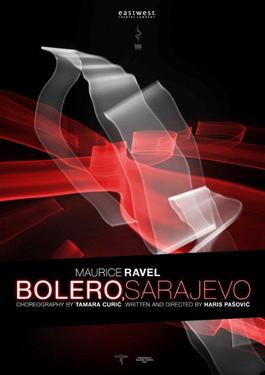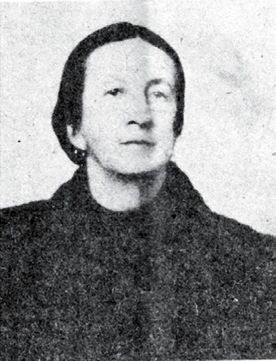Related Research Articles

Bosnia and Herzegovina, abbreviated BiH or B&H, sometimes called Bosnia–Herzegovina and often known informally as Bosnia, is a country in Southeastern Europe, located in the Balkans. Bosnia and Herzegovina borders Serbia to the east, Montenegro to the southeast, and Croatia to the north and southwest. In the south it has a narrow coast on the Adriatic Sea within the Mediterranean, which is about 20 kilometres long and surrounds the town of Neum. Bosnia, which is the inland region of the country, has a moderate continental climate with hot summers and cold, snowy winters. In the central and eastern regions of the country, the geography is mountainous, in the northwest it is moderately hilly, and in the northeast it is predominantly flat. Herzegovina, which is the smaller, southern region of the country, has a Mediterranean climate and is mostly mountainous. Sarajevo is the capital and the largest city of the country followed by Banja Luka, Tuzla and Zenica.

The culture of Bosnia and Herzegovina encompasses the country's ancient heritage, architecture, science, literature, visual arts, music, cinema, sports and cuisine.

Mehmed "Meša" Selimović was a Yugoslav writer, whose novel Death and the Dervish is one of the most important literary works in post-World War II Yugoslavia. Some of the main themes in his works are the relations between individuality and authority, life and death, and other existential problems.

The Pennsylvania Academy of the Fine Arts (PAFA) is a museum and private art school in Philadelphia, Pennsylvania. It was founded in 1805 and is the first and oldest art museum and art school in the United States.

Lesbian, gay, bisexual, and transgender (LGBT) persons in Bosnia and Herzegovina may face legal challenges not experienced by non-LGBT residents. Both male and female same-sex sexual activity are legal in Bosnia and Herzegovina. However, households headed by same-sex couples are not eligible for the same legal protections available to opposite-sex couples.

Jasmila Žbanić is a Bosnian film director, screenwriter and producer, best known for having written and directed Quo Vadis, Aida? (2020), which earned her nominations for the Academy Award for Best Foreign Language Film, the BAFTA Award for Best Film Not in the English Language, and the BAFTA Award for Best Direction.
Envera Selimović is a Bosnian journalist. She was the United Nations Department of Public Information Representative in Azerbaijan. At her appointment in 2006, she was described as "one of Bosnia’s best-known and highly respected journalists."

The Sarajevo Music Academy or Music Academy | University of Sarajevo is a Faculty of Music of University of Sarajevo in Bosnia and Herzegovina.

Izeta Selimović, known by her stage name Beba Selimović, was a Bosnian sevdalinka-folk singer and was one of the leading female singers of the 1950s, 1960s and 1970s in Yugoslavia, along with Zehra Deović, Nada Mamula and Silvana Armenulić.

Šejla Kamerić is a Bosnian visual artist.

Bolero, Sarajevo or shortened Bolero is the name of a theatre show produced by the East West Theatre Company from Bosnia and Herzegovina and Tala Dance Center from Croatia. Authors, choreographer Tamara Curic from Zagreb, Croatia and director Haris Pasovic, created a dance performance in which Sarajevo and choreography impressed with Maurice Béjart's work are in interaction. They were largely inspired by the flux of Sarajevo, Ravel's music and 'Béjartesque' swinging bodies. Performance included dancers from Zagreb who regularly collaborate with the TALA Dance Centre, actors of the East West Theatre Company from Sarajevo, and the members of the Sarajevo National Theatre's Ballet Company.

Maja Milinković is a Bosnian fado singer and songwriter, born in Sarajevo, the capital of SR Bosnia and Herzegovina.
Adela Jušić is a Bosnian contemporary visual artist. She was born in Sarajevo. She is known for her socially engaged art on the subject of the war in Bosnia and Herzegovina and the role of partisan women during the Second World War in Yugoslavia. She has exhibited her works in more than 100 international exhibitions including: Frestas – Trienal de Artes, The Women's Room, Balkan Artist Guild (London), Manifesta 8. (Murcia), ISCP, Videonale (Bonn), Image Counter Image (München). Jušić is a cofounder of the Association for Art and Culture Crvena. Adela Jušić is one of the creators of the online archive of the antifascist struggle of women in Bosnia and Herzegovina and Yugoslavia. She lives and works in Sarajevo.
Svetlana Đurković, also spelled Svetlana Durkovic, is a Croatian-born feminist, anthropologist and LGBTIQ human rights activist known as a co-founder of Organization Q, the first LGBTQIA organization in Bosnia and Herzegovina. She has worked to eradicate discrimination based on sexual orientation and gender identity in Bosnia and Herzegovina. As of 2018, she lives and works in Maryland, and Washington, D.C.
Margaret M. Taylor Fox was an American painter, illustrator, and etcher.
Queer Sarajevo Festival was the first public queer festival in Bosnia and Herzegovina, organized by Organization Q in September 2008 in Sarajevo. The Festival is remembered as the first public coming out of LGBT*IQA persons in BiH. It became the center of interest of Bosnian-Herzegovinian, regional and international public and media after the escalation of violence against Festival participants and journalists on the day of the opening. The Festival was closed for the public two days after its opening, due to counter-reactions of general public, political representatives and as the organizers, journalists and Festival participants had been physically attacked by Islamic religious extremists and nationalists.
Clarity Haynes is a queer feminist American artist and writer. She currently lives and works in New York, NY. Haynes is best known for her unconventional painted portraits of torsos, focusing on queer, trans, cis female and nonbinary bodies. She is a former member of the tART Collective and the Corpus VI Collective.

The human rights record of Bosnia and Herzegovina has been criticised over a number of years by intergovernmental organisations including the United Nations Human Rights Council, the European Court of Human Rights and the Organisation for Security and Co-operation in Europe, as well as international and domestic non-governmental organisations such as Human Rights Watch and Amnesty International. The government of Bosnia and Herzegovina has been criticised for ethnic and religious discrimination in its treatment of ethnic and religious minorities such as the Romani people and the Jewish people. The government has also been criticised for its treatment of Internally Displaced Persons following the Bosnian War and its failure to provide asylum seekers with resources such as food, shelter and medical assistance. According to BH Novinari, the Bosnian Journalists’ Association, freedom of the media is an issue in Bosnia and Herzegovina, with journalists facing attacks, threats and pressure from government. Human rights non-government organisations have also reported interference in their work from the government. The Bosnian government has been criticised by the European Union for its slow response to domestically prosecute war crimes from the Bosnian War following the closure of the International Criminal Tribunal for the Former Yugoslavia in December 2017.
Senka Marić is a Bosnian writer. She is best known for her work as a poet and for her 2018 novel Kintsugi Tijela, which draws from the author's own experiences with breast cancer. Marić is also co-founder and editor-in-chief of the literary journal Strane.

Mica Todorović was a Bosnian painter, who was a founding member of the Association of Fine Artists of Bosnia Herzegovina.
References
- 1 2 3 "ADVANCING THE ARTS ACROSS MARYLAND: Alma Selimovic". Maryland State Arts Council. Archived from the original on April 11, 2018. Retrieved December 14, 2017.
- 1 2 3 Mendelson, Winter (March 2015). "Artist Spotlight: Mixed Media Artist Alma Selimovic - Posture Magazine". posturemag.com. Retrieved 2017-12-14.
- 1 2 Franson, Todd (September 21, 2017). "Body Language: Queer Activists from Post-Yugoslavia - Metro Weekly". www.metroweekly.com. Retrieved 2017-12-14.
- ↑ "Gallery: Alma Selimovic - Metro Weekly". www.metroweekly.com. 30 June 2016. Retrieved 2017-12-14.
- 1 2 "Alma – lična priča za Kvir arhiv". www.kvirarhiv.org (in Bosnian). October 2017. Retrieved 2017-12-19.
- 1 2 "Artist information". Maryland State Arts Council. Archived from the original on April 11, 2018. Retrieved December 19, 2017.
- ↑ Čitanka lezbejskih i gej ljudskih prava (in Bosnian). Sarajevski otvoreni centar. 2011. p. 113. ISBN 9789958995934.
- 1 2 "Eight injured as Sarajevo Queer Festival attacked". www.amnesty.org. 26 September 2008. Retrieved 2017-12-14.
- 1 2 "Sarajevo Queer Festival organizers still under threat". www.amnesty.org. October 2008. Retrieved 2017-12-14.
- ↑ "Performing Queer Subjectivities | Queen's University Belfast". www.brianfrieltheatre.co.uk. Archived from the original on 2019-01-28. Retrieved 2017-12-14.
- ↑ Unkić, Hilma (July 12, 2017). "Alma Selimović: Queer umjetnošću protiv predrasuda". Diskriminacija.ba (in Bosnian). Retrieved 2017-12-19.
- ↑ "The restofus // Mi, ostalei // Alma Selimović | Okvir". www.okvir.org. July 2017. Retrieved 2017-12-19.
- ↑ Jenkins, Mark (2017-09-14). "In the galleries: Artistic reflections on what mortality leaves behind". Washington Post. ISSN 0190-8286 . Retrieved 2017-12-19.
- ↑ Selimovic, Alma. "Artist statement" (PDF). Alma Selimovic. Retrieved December 19, 2017.[ permanent dead link ]
- ↑ "PAFA Announces 2015 Fine Arts Venture Fund Recipients". www.pafa.org. Archived from the original on 2019-01-28. Retrieved 2017-12-19.
- ↑ "CV/BIO". Alma Selimovic. Archived from the original on 2019-01-28. Retrieved 2017-12-19.